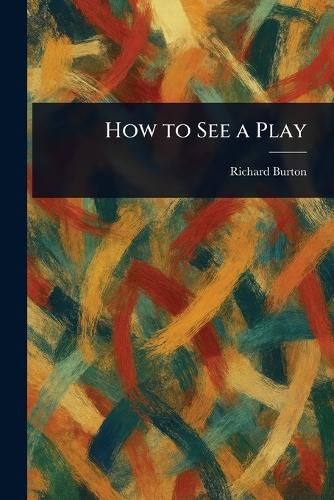Readings Newsletter
Become a Readings Member to make your shopping experience even easier.
Sign in or sign up for free!
You’re not far away from qualifying for FREE standard shipping within Australia
You’ve qualified for FREE standard shipping within Australia
The cart is loading…






This title is printed to order. This book may have been self-published. If so, we cannot guarantee the quality of the content. In the main most books will have gone through the editing process however some may not. We therefore suggest that you be aware of this before ordering this book. If in doubt check either the author or publisher’s details as we are unable to accept any returns unless they are faulty. Please contact us if you have any questions.
Discover the secrets to appreciating dramatic art with Richard Burton's "How to See a Play," a timeless guide to understanding and engaging with theater. This meticulously republished edition offers invaluable insights into dramatic criticism, exploring the nuances of playwriting, acting, and stagecraft. Burton's work provides a framework for analyzing theatrical performances, enhancing your understanding of the playwright's intent and the actors' execution. Whether you're a seasoned theatergoer or new to the world of drama, this book offers a comprehensive exploration of what makes a play truly captivating. Delve into the art of seeing beyond the surface and discover the deeper meanings within the performance. "How to See a Play" is an essential addition to any theater lover's library, providing a foundational understanding of the elements that contribute to a powerful and memorable theatrical experience.
This work has been selected by scholars as being culturally important, and is part of the knowledge base of civilization as we know it.
This work is in the public domain in the United States of America, and possibly other nations. Within the United States, you may freely copy and distribute this work, as no entity (individual or corporate) has a copyright on the body of the work.
Scholars believe, and we concur, that this work is important enough to be preserved, reproduced, and made generally available to the public. We appreciate your support of the preservation process, and thank you for being an important part of keeping this knowledge alive and relevant.
$9.00 standard shipping within Australia
FREE standard shipping within Australia for orders over $100.00
Express & International shipping calculated at checkout
This title is printed to order. This book may have been self-published. If so, we cannot guarantee the quality of the content. In the main most books will have gone through the editing process however some may not. We therefore suggest that you be aware of this before ordering this book. If in doubt check either the author or publisher’s details as we are unable to accept any returns unless they are faulty. Please contact us if you have any questions.
Discover the secrets to appreciating dramatic art with Richard Burton's "How to See a Play," a timeless guide to understanding and engaging with theater. This meticulously republished edition offers invaluable insights into dramatic criticism, exploring the nuances of playwriting, acting, and stagecraft. Burton's work provides a framework for analyzing theatrical performances, enhancing your understanding of the playwright's intent and the actors' execution. Whether you're a seasoned theatergoer or new to the world of drama, this book offers a comprehensive exploration of what makes a play truly captivating. Delve into the art of seeing beyond the surface and discover the deeper meanings within the performance. "How to See a Play" is an essential addition to any theater lover's library, providing a foundational understanding of the elements that contribute to a powerful and memorable theatrical experience.
This work has been selected by scholars as being culturally important, and is part of the knowledge base of civilization as we know it.
This work is in the public domain in the United States of America, and possibly other nations. Within the United States, you may freely copy and distribute this work, as no entity (individual or corporate) has a copyright on the body of the work.
Scholars believe, and we concur, that this work is important enough to be preserved, reproduced, and made generally available to the public. We appreciate your support of the preservation process, and thank you for being an important part of keeping this knowledge alive and relevant.